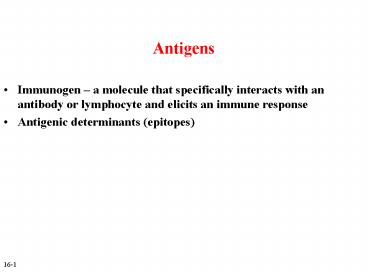Antigens - PowerPoint PPT Presentation
Title:
Antigens
Description:
Antigens Immunogen a molecule that specifically interacts with an antibody or lymphocyte and elicits an immune response Antigenic determinants (epitopes) – PowerPoint PPT presentation
Number of Views:632
Avg rating:3.0/5.0
Title: Antigens
1
Antigens
- Immunogen a molecule that specifically
interacts with an antibody or lymphocyte and
elicits an immune response - Antigenic determinants (epitopes)
2
Figure 16.3 Antibodies and Antigens
3
Antibodies
- Structure
- Protective outcomes
- Immunoglobulin classes
4
Structure
- Antigen binding (Fab) site
- Fc region
- Heavy chains and light chains
- Variable region (Fab)
- Constant region (Fc)
5
Figure 16.4 Antibody structure
6
Figure 16.5 Model of an IgG Molecule
7
Protective outcomes
- Neutralization
- Immobilization and prevention of adherence
- Agglutination and precipitation
- Opsonization
- Complement activation
- Antibody dependent cellular cytotoxicity (ADCC)
8
Figure 16.6 Protective outcomes of Ab-Ag binding
9
Immunoglobulin classes
- IgM (pentamer) first class produced
- IgG (monomer) 80-85 total serum Ig secondary
response - IgA (dimer in secretions) secreted Ab mucosal
immunity - IgD (monomer) minor Ab involved in development
- IgE (monomer) bound to basophils and mast
cells, - important in elimination of parasites, allergies
10
Table 16.1 Classes of immunoglobulins
11
Figure 16.7 Immunoglobulin G Levels in the
Fetus and Infant
12
Names for antibodies based on protective
outcome agglutinin IgG antibody that
agglutinates antigen precipitin IgG antibody
that precipitates antigen opsonin IgG that
coats antigen to promote phagocytosis complem
ent fixing antibody leads to complement
lysis antitoxin neutralizes
antigen neutralizing antibody neutralizes
ability of virus to infect
13
Clonal selection
- Specific response of a lymphocyte to an antigen
- Lymphocytes
- Immature
- Naïve
- Activated
- Effector
- Memory
14
Figure 16.8 Clonal selection
15
B - lymphocytes
- Response to T dependent antigens
- Response to T independent antigens
16
Response to T dependent antigens
- B cells present antigen (usually protein) to
effector T cells - B cell clonal expansion affinity maturation,
class switching and memory - Primary and secondary response
17
Figure 16.9 B cell and T cell interaction
18
Figure 16.10 Lymphocytes and plasma cells
19
Figure 16.12 Affinity maturation in B cells
20
Figure 16.13 Class switching in B cells and
plasma cells
21
Figure 16.11 Primary and secondary response
22
Response to T independent antigens
- Polysaccharides trigger B cell response
- No T helper cells are involved
23
Figure 16.14 - T independent antigens

